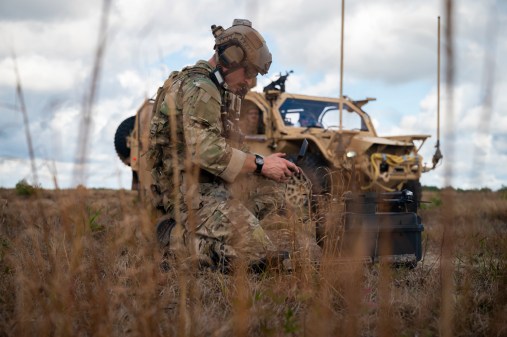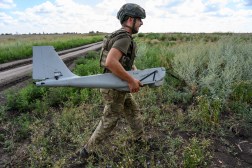SOCOM gearing up to assess air-launched kamikaze drones

U.S. Special Operations Command is getting ready for what it’s calling an “assessment event” to examine industry’s air-launched kamikaze drones, with an eye toward rapidly fielding new capabilities.
Ground-launched loitering munitions have proliferated across battlefields in recent years including in Ukraine and the Middle East. Now, SOCOM is looking for similar weapons that can be dropped from a variety of aircraft in its inventory, including gunships, helicopters and large unmanned aerial systems.
The command began accepting capability submissions this week, and a downselect is slated for March. Those that make the cut will receive an invitation to attend the assessment event in April at the SOFWERX facility in Tampa, Florida, where they can pitch and showcase their tech, according to a special notice posted on Sam.gov.
Unlike traditional munitions, kamikaze drones can fly around until they identify a target. And unlike armed unmanned aerial systems that launch missiles, kamikaze drones destroy their target by crashing into it.
SOCOM’s stand-off precision guided munitions program office “currently supports Special Operations Forces (SOF) aircrews with short range munitions that are employed directly to known targets, visually identified by the shooter aircraft before launch, and use existing precision terminal guidance solutions such as Global Positioning System (GPS). USSOCOM has determined these traditional methods and sensors are not optimal for operations in a time compressed and highly contested environment and is looking for [air-launched loitering munitions] with improved sensor technologies to decrease the engagement time from minutes to seconds, improve targeting solutions, and increase the survivability of SOF,” according to the special notice.
The command “intends to survey industry for mature technology with minimum development required to support rapid fielding of this capability,” the notice states. “If the USSOCOM evaluation panel favorably evaluates a solution brief, negotiations for [the next phase] may immediately begin.”
The next phase will include flight demonstrations anticipated for later this year. Those events will give the command a pathway to downselect systems for full integration, operational testing, production and fielding, according to officials.
The desired endurance for the loitering munitions is 45 minutes for weapons that can be deployed from a common launch tube, and 120 minutes for those that use other launch methods. The desired range for those is 20 nautical miles and 60 nautical miles, respectively, according to assessment criteria provided by SOFWERX.
Other characteristics of interest include minimum and maximum airspeed and altitude; payload capacity; sensors and seekers; command and control; counter-detection; warhead and fusing; aircraft integration standards; and employment from a variety special ops aircraft.
The command is eyeing loitering munitions that could be deployed from AC-130J Ghostrider gunships, MQ-9 Reaper drones, MH-60 helicopters and other platforms.
Submissions from those who wish to participate in the assessment event are due March 15.
SOCOM isn’t the only Defense Department component on the hunt for air-launched drones with loitering capabilities.
For example, the Army has a Launched Effects program. In December, the service conducted a successful flight test involving the launch of an Anduril-made Altius 700 unmanned aerial system from a Black Hawk helicopter, according to a release.
Anduril has developed a loitering munition variant of the system known as the Altius 700M.
The Army planned to conduct a flight test of a fully integrated launched-effects prototype early this year. The service is aiming for a final operational demonstration by the end of fiscal 2024 and a rapid fielding decision in 2025, per the release.






